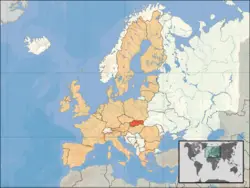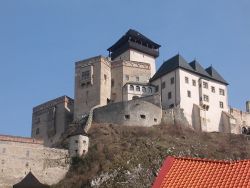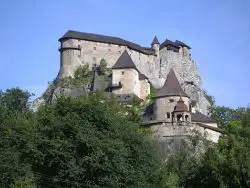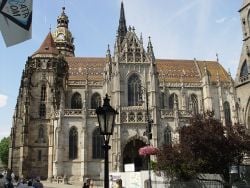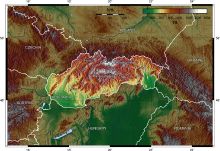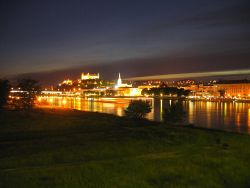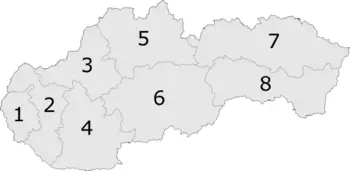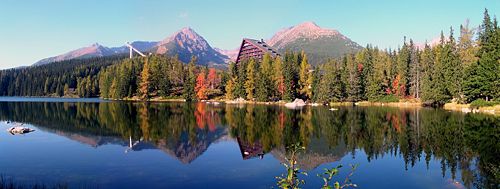Difference between revisions of "Slovakia" - New World Encyclopedia
| Line 120: | Line 120: | ||
===Slovak National Uprising=== | ===Slovak National Uprising=== | ||
| − | In 1943, the Slovak State | + | In 1943, the Slovak State started feeling severe problems with supply amid rampant corruption and usury. The “Oasis of Affluence” was losing its luster, and even the fact that Germany and other neighboring countries were under greater deprivation could not stem the growing discontent. Politicians with anti-German leanings publicly acknowledged the existence of [[Czechoslovakia]] in the Christmas Agreement and proclaimed allegiance to the joint state of Czechs and Slovaks against Hitler’s Germany. Crucial to the agreement was the preparation of an armed conflict and removal of the HSĽS from power. |
| − | Pro-democratic | + | Pro-democratic citizens began participating in resistance movement, and two-thirds of the Slovak currency was made available to the cause. Weaponry, which at one time came in handy to the Fascist Germany, was transferred surreptitiously to the designated centers of the uprising. In August 1944, the [[United States of America|U.S.]] Air Force bombed a state-owned refinery in Central Slovakia despite multiple warnings sent to the exiled Czechoslovak government in [[London]] that the refinery was crucial to the uprising-in-the-works. |
| − | The Slovak National Uprising broke out on August 29, 1944 and a few days later the joint state of Czechs and Slovaks was to be restored as a federal structure | + | The Slovak National Uprising broke out on August 29, 1944, and a few days later the joint state of Czechs and Slovaks was to be restored as a federal structure. Black market practices and corruption that had been tolerated by the government and paramilitary Hlinka's Guard (Hlinkova Garda) were being reversed. The final stage of the uprising was in the spirit of partisan activities rather than open resistance. |
===After WWII=== | ===After WWII=== | ||
| − | After [[World War II]], Slovakia | + | After [[World War II]], Slovakia became part of [[Czechoslovakia]] as a satellite of the [[Communism|Communist]] [[Soviet Union]] and its [[Warsaw Pact]]. In 1968, Czechoslovakia courted liberation from the Communist grip in the events referred to as the [[Prague Spring]], when it made an attempt to reform the regime from within and embark on the path toward liberalization and a multi-party system. Slovak-born Alexander Dubček became a symbol of these developments. However, the Warsaw Pact armies invaded and crushed Czechoslovakia's hopes under the tanks as the Western world watched by. In 1969, Czechoslovakia was reorganized as a federation of the [[Czech Republic|Czech Socialist Republic]] and the Slovak Socialist Republic. |
| − | The end of the infamous 40 years | + | The end of the infamous 40 years finally came in 1989, during the peaceful Velvet Revolution. Four years later, on January 1, 1993, the country was dissolved once again into two successor states. Slovakia and the Czech Republic went their own ways after the Velvet Divorce but have remained close partners. Slovakia joined the [[European Union]] in May 2004. |
==Geography== | ==Geography== | ||
[[Image:Slovakia_topo.jpg|220px|thumb|Relief]] | [[Image:Slovakia_topo.jpg|220px|thumb|Relief]] | ||
| − | The Slovak landscape is | + | The Slovak landscape is crowned by the Carpathian Mountains extending across most of the northern half of the country. The most notable range is the Tatras, home to scenic lakes and valleys as well as the highest peak, the Gerlachovský štít (2,655 metres/8,711 ft). The [[Danube]], Váh, and Hron are the largest rivers. The climate is temperate, with relatively warm summers and cold, cloudy and humid winters. |
| − | |||
| − | The | ||
==Demographics== | ==Demographics== | ||
[[Image:Bratislava View From Petrzalka Old City Part.jpg|250px|thumb|Bratislava Old Town]] | [[Image:Bratislava View From Petrzalka Old City Part.jpg|250px|thumb|Bratislava Old Town]] | ||
| − | + | Slovaks form 86% of the population, with Hungarians being the largest ethnic minority (9.7%), concentrated in the southern and eastern regions of the country. Several municipalities, such as Dunajská Streda, Komárno, Šahy, and Želiezovce, are majority Hungarian. Other ethnic groups include [[Roma]], Czechs, Ruthenians, [[Ukraine|Ukrainians]] and Germans. Some 68.9 % of the country identify themselves with [[Roman Catholicism]], followed by [[Protestant|Lutheranism]] (6.93%), and Greek Catholicism (4.1%). About 2,300 [[Jew]]s remain of the 120,000-strong pre-WWII population. The official language is Slovak, a member of the Slavic language family, but Hungarian is widely spoken in the south and enjoys the same status as does Slovak language in some regions. | |
| − | |||
| − | |||
| − | |||
==Politics== | ==Politics== | ||
[[Image:Bojnice_Castle.JPG|250px|thumb|Bojnice Castle, the only one of its design in Central Europe.]] | [[Image:Bojnice_Castle.JPG|250px|thumb|Bojnice Castle, the only one of its design in Central Europe.]] | ||
| − | Slovakia is a parliamentary democratic republic with a multi-party system. The | + | Slovakia is a parliamentary democratic republic with a multi-party system. The head of state is the president (Ivan Gašparovič, 2004-2009), elected in a direct popular vote for a five-year term. Executive power is concentrated in the hands of the prime minister (Róbert Fico, 2006-2010), who is most frequently the leader of the winning party and has to form a majority coalition in the parliament. The prime minister is appointed by the president. The remainder of the cabinet is appointed by the president on the recommendation of the prime minister. |
| − | The | + | The highest legislative body is the 150-seat unicameral National Council of the Slovak Republic (''Národná rada Slovenskej republiky''). Delegates are elected for a four-year term on the basis of a proportional representation. The Constitutional Court (''Ústavný súd'') is the highest judicial body; its 13 members are appointed by the president. |
| − | Slovakia | + | Slovakia joined the [[European Union]] on May 1, 2004, and [[NATO]] on March 29, 2004. As a member of the [[United Nations]] since 1993, it was, on October 10, 2005, for the first time elected to a two-year term on the [[UN Security Council]]. |
| − | |||
| − | |||
==Administrative divisions== | ==Administrative divisions== | ||
| − | + | Slovakia is subdivided into eight regions/countries (''kraje'') named after their respective principal cities. The regions enjoy a degree of autonomy. | |
[[Image:Slovakiakrajenumbers.png|right|350px]] | [[Image:Slovakiakrajenumbers.png|right|350px]] | ||
| Line 172: | Line 165: | ||
(the word ''kraj'' can be replaced by ''samosprávny kraj'' or by ''VÚC'' in each case) | (the word ''kraj'' can be replaced by ''samosprávny kraj'' or by ''VÚC'' in each case) | ||
| − | The | + | The regions are further subdivided into 79 districts (''okresy''). |
| − | In terms of | + | In terms of economy and unemployment rate, the western regions fare better than the eastern regions. |
==Economy== | ==Economy== | ||
| − | + | Slovakia has mastered much of the transition from the centrally planned economy to a modern market economy and implemented crucial macroeconomic reforms in 2001. | |
| − | Slovakia has mastered much of the | ||
Solid domestic demand boosted economic growth to 4.1% in 2002. Strong export growth, in turn, pushed economic growth to a still-strong 4.2% in 2003 and 5.4% in 2004, despite a downturn in household consumption. Multiple reasons entailed a GDP growth of 6% in 2005, the 4th highest rate in the [[European Union|EU]] (after the three Baltic states). The GDP growth is expected to reach at least 7.7% in 2006 (the year-to-year growth amounted to unexpected 9.8% in the 3th quarter, which helped to increase the overall year economy growth expectation to 7.7%), and 6.5% in 2007. The 9.8% growth came as a surprise to local analysts (6 % were expected), given that the big foreign investor Kia is going to launch its production only in late 2006. | Solid domestic demand boosted economic growth to 4.1% in 2002. Strong export growth, in turn, pushed economic growth to a still-strong 4.2% in 2003 and 5.4% in 2004, despite a downturn in household consumption. Multiple reasons entailed a GDP growth of 6% in 2005, the 4th highest rate in the [[European Union|EU]] (after the three Baltic states). The GDP growth is expected to reach at least 7.7% in 2006 (the year-to-year growth amounted to unexpected 9.8% in the 3th quarter, which helped to increase the overall year economy growth expectation to 7.7%), and 6.5% in 2007. The 9.8% growth came as a surprise to local analysts (6 % were expected), given that the big foreign investor Kia is going to launch its production only in late 2006. | ||
| Line 186: | Line 178: | ||
[[Inflation]] dropped from an average annual rate of 12.0% in 2000 to just 3.3% in the election year 2002, but it rose again in 2003-2004 because of increases in taxes and regulated prices. It reached 3.7 % in 2005. | [[Inflation]] dropped from an average annual rate of 12.0% in 2000 to just 3.3% in the election year 2002, but it rose again in 2003-2004 because of increases in taxes and regulated prices. It reached 3.7 % in 2005. | ||
| − | Slovakia plans to adopt the [[Euro]] currency on 1 January 2009 and has already entered the European Exchange Rate Mechanism for this purpose | + | Slovakia plans to adopt the [[Euro]] currency on 1 January 2009 and has already entered the European Exchange Rate Mechanism for this purpose. |
Slovakia is among the most attractive countries in the EU for foreign investors mainly because of its low labour costs (a 2005 survey by the prominent consultant firm Deloitte shows that Slovakia has the lowest labour costs in the European Union) and low tax rates. This issue has sparked criticism from some other EU countries, which accuse Slovak government of social and tax dumping. In recent years, Slovakia has been pursuing a policy of encouraging foreign investment. However, that has not shown any benefits so far in innovation capabilities within the country. | Slovakia is among the most attractive countries in the EU for foreign investors mainly because of its low labour costs (a 2005 survey by the prominent consultant firm Deloitte shows that Slovakia has the lowest labour costs in the European Union) and low tax rates. This issue has sparked criticism from some other EU countries, which accuse Slovak government of social and tax dumping. In recent years, Slovakia has been pursuing a policy of encouraging foreign investment. However, that has not shown any benefits so far in innovation capabilities within the country. | ||
| Line 192: | Line 184: | ||
Despite a sufficient number of researchers and a solid secondary educational system, Slovakia (as well as some other post-communist countries) still faces many challenges in the field of modern knowledge economy. Within the EU, Slovakia ranks next to last on knowledge creation and last for innovation and entrepreneurship. The business and public Research and development expenditures are deeply below EU average. World Bank urges Slovakia to upgrade information infrastructure and reform education system, OECD states that a stronger product market competition would help. | Despite a sufficient number of researchers and a solid secondary educational system, Slovakia (as well as some other post-communist countries) still faces many challenges in the field of modern knowledge economy. Within the EU, Slovakia ranks next to last on knowledge creation and last for innovation and entrepreneurship. The business and public Research and development expenditures are deeply below EU average. World Bank urges Slovakia to upgrade information infrastructure and reform education system, OECD states that a stronger product market competition would help. | ||
| − | + | [[Image:STRBSKE PLESO.jpg|thumb|500px|left|[[High Tatras]]]] | |
| − | |||
| − | |||
| − | |||
| − | |||
| − | |||
| − | |||
==Notes== | ==Notes== | ||
Revision as of 04:32, 19 March 2007
| Slovenská republika Slovak Republic | |||||
| |||||
| Anthem: Nad Tatrou sa blýska ("Lightning over the Tatras") | |||||
|
Map showing the location of Slovakia (dark orange) within the EU (legend). | |||||
| Capital (and largest city) |
Bratislava | ||||
| Official languages | Slovak | ||||
|---|---|---|---|---|---|
| Government | Parliamentary democracy | ||||
| - President | Ivan Gašparovič | ||||
| - Prime Minister | Robert Fico | ||||
| Independence | from Czechoslovakia | ||||
| - Date | January 1 19931 | ||||
| Accession to EU | May 1 2004 | ||||
| Area | |||||
| - Total | 49,037 km² (130th) 18,933 sq mi | ||||
| - Water (%) | negligible | ||||
| Population | |||||
| - July 2005 estimate | 5,401,000 | ||||
| - 2001 census | 5,379,455 | ||||
| - Density | 111/km² 287/sq mi | ||||
| GDP (PPP) | 2005 estimate | ||||
| - Total | $87.32 billion | ||||
| - Per capita | $16,041 | ||||
| HDI (2004) | |||||
| Currency | Slovak koruna (1 koruna = 100 haliers) (SKK)
| ||||
| Time zone | CET (UTC+1) | ||||
| - Summer (DST) | CEST (UTC+2) | ||||
| Internet TLD | .sk2 | ||||
| Calling code | +4213 | ||||
| 1 Czechoslovakia split into the Czech Republic and Slovakia; see Velvet Divorce. 2 Also .eu, shared with other European Union member states. | |||||
Slovakia (Slovak: Slovensko) is a landlocked country in Central Europe with a population of over five million. It is a member of the European Union (since May 1 2004) and borders Czech Republic and Austria in the west, Poland in the north, Ukraine in the east and Hungary in the south. The largest city is its capital, Bratislava.
Name
The longer version of the country's name is Slovak Republic (Slovenská republika), in the same way as Germany stands for the Federal Republic of Germany or France for the French Republic.
Before the 5th Century
From around 450 B.C.E., Slovakia was settled by Celts, who built powerful oppida in Bratislava and Liptov. Silver coins bearing the names of Celtic kings are the source of the first archaelogically proven use of an alphabet. From 6 C.E., the expanding Roman Empire established and maintained a chain of outposts around the Danube River. The barbarian Kingdom of Vannius, founded by the Germanic tribe of Quadi, existed in western and central Slovakia between 20 to 50 c.e..
Slavic States
The Slavic tribes settled in Slovakia in the 5th century, with the most glorious periods being those of the King Samo’s Empire and the Principality of Nitra. The latter became part of the Great Moravian Empire.
King Samo’s Empire: (623-658)
Slavs inhabiting Slovakia were under the constant threat of nomadic Avars until their defeat in 623, thanks partly to the Frankish merchant Samo. Being a wealthy man operating in the territory of central and eastern Europe, Samo realized that the Slavs, given to feuds and animosity, would benefit greatly from the shipment of weapons, so he armed them and led them to the war against the Avars. The Slavs then elected him their king. Samo’s Empire was the first known organized community of Slavs, operating as a confederation of more or less independent principalities in the fashion of the Frankish empire. Samo is credited for spearheading the process of the pacification of Slavic tribes, who were thus able to refocus their energies on agriculture and gave up looting expeditions. After his death, the empire dissolved into principalities, which were later consolidated within the Great Moravian Empire.
The Great Moravian Empire: (833-906)
A proto-Slovak state, the Principality of Nitra, arose in the 8th century. Its ruler Pribina ordered consecration of the first Christian church in Slovakia in 828. Together with neighboring Moravia, the principality formed the core of the Great Moravian Empire from 833, when the first documented prince of Great Moravia, Mojmír I (830-846), conquered the Principality of Nitra and unseated Pribina. The empire was booming under Prince Rastislav (846-870), who, aware of the importance of Christianity to the strengthening of his rule, acceptance by the advanced European countries, and political backing by the Byzantine Empire, asked the Byzantine emperor to send a bishop that would spread Christianity in the language understandable to local Slavs. Brothers Cyril and Methodius, Greek by nationality, were dispatched in 863, but before they arrived, the extremely learned Cyril put together a Slavic alphabet, Glagolitic, and translated part of the Scriptures into it. The language they were using was called Old Slavonic; it resembled the vernacular used in Great Moravia and became the language of worship. The brothers taught their disciples the new language and the alphabet, giving rise to the first works of Slavonic literature. However, Bavarian bishops found their work disrupting and accused them of spreading heresy in a language that was not Latin, so the brothers left for Rome to defend themselves in front of the Pope, who was forced to allow the usage of the language.
Under Svätopluk (870-894), the empire occupied the areas of the Czech Republic, Slovakia, southwestern Poland, southeastern Germany, Hungary, northern and eastern Austria, and western Romania, totaling 350,000 square kilometers with an estimated population of 1.5 million. It was the first joint (proto-)state of Czechs and Slovaks. A crossroads of major European trading routes, it was on par with the neighboring Frankish Empire, with a developed judicial system. It assimilated cultures of the West, penetrating from Western Europe, and the East, symbolized by Christianity spreading from the Byzantine Empire. The cities Nitra and Bratislava were among its major centers.
Svätopluk’s successor Mojmír II (894-906) faced attacks from both the Franks and nomadic Hungarian tribes, and in 906, the Hungarians conqured it, which some historians attribute to the uncontrolled population growth of Hungarians in the southern parts of the empire without safeguarding the same for the Slavic citizens. The Slavs purportedly hoped that the Hungarians would assimilate into the Slavic state. Czechs and Slovaks were to be disjoined for a thousand years, until 1918, when the federal Czechoslovakia would be established.
Kingdom of Hungary
The Magyars gradually occupied Slovakia, which, nevertheless, retained its privileges in this new state because of its high level of economic and cultural development. For almost two centuries, Slovakia was ruled autonomously as the Principality of Nitra within the Kingdom of Hungary. Slovak settlements extended to the northern half of present-day Hungary, while Hungarians later settled down in the southern part of Slovakia. The ethnic composition became more diverse with the arrival of the Carpathian Germans in the 13th century, Vlachs in the 14th century, and Jews.
A huge population loss resulted from the invasion of the Mongols in 1241 and the subsequent famine. However, medieval Slovakia was characterized rather by burgeoning towns, construction of numerous stone castles, and the development of arts. In 1467, King Matthias Corvinus established the first university in Bratislava, although the institution was short-lived.
After the Ottoman Empire started expanding into Hungary and invaded Budapest in the early 16th century, the center of the Kingdom of Hungary shifted toward Slovakia, and Bratislava (Pressburg, Pressporek, Pozsonium or Pozsony) became the capital in 1536. The Ottoman wars and frequent insurrections against the Habsburg Monarchy inflicted a great deal of destruction, especially in rural areas. As the Turks retreated from Hungary in the 18th century, Slovakia's standing within the kingdom decreased, although Bratislava retained its position of the capital city of Hungary until 1848, when the capital was moved back to Budapest.
National Revival Movement
The first attempt to enact the literary Slovak language (based on the western Slovakian dialect) came in 1787 by Anton Bernolák, but it was not accepted by Slovak Protestants. Only the 1843 version of the language, authored by Štúr, Hurban, and Hodža and based on the central Slovakian dialect, has won the support of general public. Lacking a state structure of its own, Slovakia was forced to enlist assistance with the revival cause from similar ideological movements in Hungary. However, Hungary in 1840s changed course toward a quest for a unified state independent of Austria, which was not be endorsed by Slovaks, who had been suppressed by Hungarians since the outset of the Kingdom of Hungary.
In May 1848, Requests of the Slovak Nation were drafted calling for the use of the Slovak language in schools and public offices, but neither Hungary nor Austria took those seriously. Nor did the European Revolutions of 1848 bring about a turnaround, as Hungary stepped up repressions of non-Hungarian nationalities, particularly after the forming of the Dual Monarchy, whereby Hungary became independent of Vienna. In 1870s, Magyars closed down Slovak high schools and the national institute for the promotion of Slovak culture (Matica slovenská) as Magyarization was forced on Slovaks in all aspects of life. This continued until the emergence of Czechoslovakia in 1918. Still, this was an important period in the life of the nation, as it accelerated the breakdown of feudalism and foreshadowed the emergence of an independent Slovak state later on. It was carried out by intelligentsia, mostly of non-aristocratic background, and the movement was thus more democratic by nature.
Czechs, on the other hand, had to put up with Germanization, which ultimately brought the two nations close together, also because of Slovakia's disappointment with Hungarian reformists who were increasingly unwilling to fit the Slovak agenda within their own, and later crystallized into the idea of a joint state of Czechs and Slovaks, promulgated by Štefánik, Masaryk, and Beneš. However, the multi-ethnic makeup of the Austro-Hungarian Empire did not allow for a free pursuit of these goals; therefore, sympathies of the outside world had to be secured – Czechoslovak Legions as well as the Czechoslovak National Council (1916) were formed, and ties were made with European statesmen. In 1915, the Cleveland Agreement laid out an equal position of both countries within the future Czecho-Slovak federal republic.
20th Century
Czechoslovak Republic
In 1918, Slovakia joined the regions of Bohemia and neighbouring Moravia to form Czechoslovakia. During the chaos following the breakup of Austro-Hungarian Empire, it was attacked in 1919 by the provisional Hungarian Soviet Republic and one-third of its territory temporarily became the Slovak Soviet Republic.
Although the 1920 Constitution of the Czechoslovak Republic guaranteed certain country-specific rights and privileges to Slovakia, they were not fully respected, in contradiction with the Pittsburgh Agreement of 1918 that stipulated autonomous rights for Slovaks, including the right to the Slovak language as the official language of Slovakia. The policy was based on Czechoslovakism, a doctrine that originated during World War I in an effort to create a joint state of Czechs and Slovaks by means of unification, especially of the two languages. A large number of Czechs came to alleviate Slovakia’s shortage of managers and civil servants, although this became a source of controversy with time when the Czechs continued to control the lucrative posts even after the Slovak intelligentsia was brought up. Frustration gave in to an anti-government demonstration staged by Andrej Hlinka, who formed Hlinka’s Slovak People’s Party (HSĽS) as a platform to enforce demands for a separate parliament, administrative bodies, judiciary, and the official language. His party played a major role in the subsequent Slovak State. Nevertheless, historians agree that the existence of Czechoslovakia has benefited Slovakia greatly in that it allowed it to almost close the economic and cultural gap with its western neighbor.
In between World War I and World War II, the existence of the democratic and prosperous Czechoslovakia was jeopardized by revisionist governments of Germany and Hungary, until it was finally split by the Munich Agreement of 1938.
Slovak State
The infamous Munich Treaty of September 1938 resulted in the unification of most political parties around the HSĽS-sponsored demand for the political autonomy of Slovakia and thus the decentralization of the executive and legislative power of Czechoslovakia. The Prague government of General Jan Syrovy did not oppose these demands, and the acting head of the HSĽS, Jozef Tiso, was appointed as minister for the administration of Slovakia. On November 22, 1938, Slovakia’s political autonomy was signed into law, although part of its territory was taken over by Hungary, and Germany occupied portions of Bratislava. Democratic reforms quickly gave in to an authoritarian rule marked by political censorship and a forceful unification of political parties and social organizations. The HSĽS leadership was gradually overpowered by its radical wing vying for no less than an absolute independence of the country, to which the Czechoslovak government responded with intervention and internment of 250 Slovak radicals. To Slovakia, this felt as an attack on its autonomy.
In the meantime, Hitler took advantage of Slovakia's aspirations and invited Tiso to Berlin to coerce him into the secessesion of Slovakia and thus the liquidation of Czechoslovakia. Should Tiso disagree, Slovakia would be given to Hungary. On March 14, 1939, the Slovak Parliament gave a green light to the Slovak State, with the new government headed by Tiso. However, Czechoslovakia did not cease to exist; it continued its existence via an exiled government and armed forces as well as foreign embassies. At the same time, the independent Slovakia had its hands tied by agreements with Germany and generally had no choice but to align its economy with Hitler's plans, who found it all too easy to control the country headed by the corrupt leadership backed by the Catholic Church. Slovakia even had its own currency, but because Germany did not honor the economic agreements and, paradoxically, incurred a large debt, the Slovak government resorted to anti-Jewish measures to replenish its coffers. In September 1940, the government ordered registration of the Jewish property, which was then confiscated, totaling 3,187,657 Slovak crowns.
Despite plundering by Germany, Slovakia boasted one of the most stable economies among neighboring countries. This was reinforced by the statement used by state officials that Slovakia remains to be an “oasis of affluence amid starving and bleeding Europe”.[1] The tendency was toward centralization, mergers of businesses and their subsequent state control, and nationalization of natural resources. Employment was at its highest, mostly as a consequence of the resettlement of 20,000 Czech civil servants and the elimination of Jews from the economic life and later on their transport to Nazi concentration camps. Education, science, and arts underwent revitalization.
The plight of Slovak Jews under the Slovak State continues to haunt Slovakia’s past, and the anti-Jewish laws of 1940, mandating Aryanization, prove that anti-Semitism ran amok already prior to deportations. Jews were prohibited from the acquisition of businesses, were allowed to lease and handle immovables and movables only with a prior written permission, and their trade licenses were revised and businesses marked as Jewish. In the next batch of legislation, the government assigned itself the right to adopt all measures required to exclude Jews from the Slovak economic and social life and transfer Jewish ownership to Christians, and, finally, to deport them, to be paid with the proceeds from the confiscated Jewish property. These laws had an impact on Slovakia’s economy, as many people, especially the executors of the Aryanization laws, pocketed the Jewish wealth and occupied their vacated apartments.
Slovak National Uprising
In 1943, the Slovak State started feeling severe problems with supply amid rampant corruption and usury. The “Oasis of Affluence” was losing its luster, and even the fact that Germany and other neighboring countries were under greater deprivation could not stem the growing discontent. Politicians with anti-German leanings publicly acknowledged the existence of Czechoslovakia in the Christmas Agreement and proclaimed allegiance to the joint state of Czechs and Slovaks against Hitler’s Germany. Crucial to the agreement was the preparation of an armed conflict and removal of the HSĽS from power.
Pro-democratic citizens began participating in resistance movement, and two-thirds of the Slovak currency was made available to the cause. Weaponry, which at one time came in handy to the Fascist Germany, was transferred surreptitiously to the designated centers of the uprising. In August 1944, the U.S. Air Force bombed a state-owned refinery in Central Slovakia despite multiple warnings sent to the exiled Czechoslovak government in London that the refinery was crucial to the uprising-in-the-works.
The Slovak National Uprising broke out on August 29, 1944, and a few days later the joint state of Czechs and Slovaks was to be restored as a federal structure. Black market practices and corruption that had been tolerated by the government and paramilitary Hlinka's Guard (Hlinkova Garda) were being reversed. The final stage of the uprising was in the spirit of partisan activities rather than open resistance.
After WWII
After World War II, Slovakia became part of Czechoslovakia as a satellite of the Communist Soviet Union and its Warsaw Pact. In 1968, Czechoslovakia courted liberation from the Communist grip in the events referred to as the Prague Spring, when it made an attempt to reform the regime from within and embark on the path toward liberalization and a multi-party system. Slovak-born Alexander Dubček became a symbol of these developments. However, the Warsaw Pact armies invaded and crushed Czechoslovakia's hopes under the tanks as the Western world watched by. In 1969, Czechoslovakia was reorganized as a federation of the Czech Socialist Republic and the Slovak Socialist Republic.
The end of the infamous 40 years finally came in 1989, during the peaceful Velvet Revolution. Four years later, on January 1, 1993, the country was dissolved once again into two successor states. Slovakia and the Czech Republic went their own ways after the Velvet Divorce but have remained close partners. Slovakia joined the European Union in May 2004.
Geography
The Slovak landscape is crowned by the Carpathian Mountains extending across most of the northern half of the country. The most notable range is the Tatras, home to scenic lakes and valleys as well as the highest peak, the Gerlachovský štít (2,655 metres/8,711 ft). The Danube, Váh, and Hron are the largest rivers. The climate is temperate, with relatively warm summers and cold, cloudy and humid winters.
Demographics
Slovaks form 86% of the population, with Hungarians being the largest ethnic minority (9.7%), concentrated in the southern and eastern regions of the country. Several municipalities, such as Dunajská Streda, Komárno, Šahy, and Želiezovce, are majority Hungarian. Other ethnic groups include Roma, Czechs, Ruthenians, Ukrainians and Germans. Some 68.9 % of the country identify themselves with Roman Catholicism, followed by Lutheranism (6.93%), and Greek Catholicism (4.1%). About 2,300 Jews remain of the 120,000-strong pre-WWII population. The official language is Slovak, a member of the Slavic language family, but Hungarian is widely spoken in the south and enjoys the same status as does Slovak language in some regions.
Politics
Slovakia is a parliamentary democratic republic with a multi-party system. The head of state is the president (Ivan Gašparovič, 2004-2009), elected in a direct popular vote for a five-year term. Executive power is concentrated in the hands of the prime minister (Róbert Fico, 2006-2010), who is most frequently the leader of the winning party and has to form a majority coalition in the parliament. The prime minister is appointed by the president. The remainder of the cabinet is appointed by the president on the recommendation of the prime minister.
The highest legislative body is the 150-seat unicameral National Council of the Slovak Republic (Národná rada Slovenskej republiky). Delegates are elected for a four-year term on the basis of a proportional representation. The Constitutional Court (Ústavný súd) is the highest judicial body; its 13 members are appointed by the president.
Slovakia joined the European Union on May 1, 2004, and NATO on March 29, 2004. As a member of the United Nations since 1993, it was, on October 10, 2005, for the first time elected to a two-year term on the UN Security Council.
Administrative divisions
Slovakia is subdivided into eight regions/countries (kraje) named after their respective principal cities. The regions enjoy a degree of autonomy.
- Bratislava Region (Bratislavský kraj) (capital Bratislava)
- Trnava Region (Trnavský kraj) (capital Trnava)
- Trenčín Region (Trenčiansky kraj) (capital Trenčín)
- Nitra Region (Nitriansky kraj) (capital Nitra)
- Žilina Region (Žilinský kraj) (capital Žilina)
- Banská Bystrica Region (Banskobystrický kraj) (capital Banská Bystrica)
- Prešov Region (Prešovský kraj) (capital Prešov)
- Košice Region (Košický kraj) (capital Košice)
(the word kraj can be replaced by samosprávny kraj or by VÚC in each case)
The regions are further subdivided into 79 districts (okresy).
In terms of economy and unemployment rate, the western regions fare better than the eastern regions.
Economy
Slovakia has mastered much of the transition from the centrally planned economy to a modern market economy and implemented crucial macroeconomic reforms in 2001.
Solid domestic demand boosted economic growth to 4.1% in 2002. Strong export growth, in turn, pushed economic growth to a still-strong 4.2% in 2003 and 5.4% in 2004, despite a downturn in household consumption. Multiple reasons entailed a GDP growth of 6% in 2005, the 4th highest rate in the EU (after the three Baltic states). The GDP growth is expected to reach at least 7.7% in 2006 (the year-to-year growth amounted to unexpected 9.8% in the 3th quarter, which helped to increase the overall year economy growth expectation to 7.7%), and 6.5% in 2007. The 9.8% growth came as a surprise to local analysts (6 % were expected), given that the big foreign investor Kia is going to launch its production only in late 2006.
Unemployment, rising from 14.9 % at the end of 1998 to 19.2% at the end of 2001 (seasonally adjusted harmonised rate) during the radical reforms introduced by the Slovak government since 1999, decreased again to some 12% (autumn 2006), but still remains among the highest ones in the EU.
Inflation dropped from an average annual rate of 12.0% in 2000 to just 3.3% in the election year 2002, but it rose again in 2003-2004 because of increases in taxes and regulated prices. It reached 3.7 % in 2005.
Slovakia plans to adopt the Euro currency on 1 January 2009 and has already entered the European Exchange Rate Mechanism for this purpose.
Slovakia is among the most attractive countries in the EU for foreign investors mainly because of its low labour costs (a 2005 survey by the prominent consultant firm Deloitte shows that Slovakia has the lowest labour costs in the European Union) and low tax rates. This issue has sparked criticism from some other EU countries, which accuse Slovak government of social and tax dumping. In recent years, Slovakia has been pursuing a policy of encouraging foreign investment. However, that has not shown any benefits so far in innovation capabilities within the country.
Despite a sufficient number of researchers and a solid secondary educational system, Slovakia (as well as some other post-communist countries) still faces many challenges in the field of modern knowledge economy. Within the EU, Slovakia ranks next to last on knowledge creation and last for innovation and entrepreneurship. The business and public Research and development expenditures are deeply below EU average. World Bank urges Slovakia to upgrade information infrastructure and reform education system, OECD states that a stronger product market competition would help.
Notes
Further reading
- Kirschbaum, Stanislav J, A history of Slovakia : the struggle for survival, New York, St. Martin's Press, 1995, ISBN 0312104030 - ISBN 9780312104030 OCLC 30783512
- Axworthy, Mark, Axis Slovakia : Hitler's Slavic wedge, 1938-1945, Bayside, N.Y., Axis Europa Books, 2002, ISBN 1891227416 OCLC 51251521
- Jacobs, Michael, Czech & Slovak Republics, London, A.&C. Black, 1999, ISBN 071364429X -ISBN 9780713644296 - ISBN 0393319326 - ISBN 9780393319323 OCLC 41469127
- Horn, Alfred, Czech & Slovak republics, Hong Kong, APA Publications; Boston, Houghton Mifflin, 1993, ISBN 0395659876 - ISBN 9780395659878 OCLC 28178634
- Wilson, Neil; Nebeský, Richard, Czech & Slovak republics, Oakland, CA, Lonely Planet, 2001, ISBN 1864502126 - ISBN 9781864502121 OCLC 46613911
- Junas, Lil, My Slovakia : an American's view Martin, Slovakia, Vydavatelśtvo Matice slovenskej, 2001, ISBN 8070906227 OCLC 52032147
- Humphreys, Rob; Adamczak, Slawomir, The rough guide to the Czech and Slovak Republics, New York, Rough Guides, 2006, ISBN 1843535254 - ISBN 9781843535256 OCLC 63916632
- Drobná, Ol̕ga; Drobný, Eduard; Gocnikova, Magdalena, Slovakia, the heart of Europe, IL, USA; Bolchazy-Carducci Publishers, Bratislava; Perfekt, 1996, ISBN 0865163197 OCLC 34933760
- Bartl, Július, Slovak History: Chronology & Lexicon, Wauconda, IL, Bolchazy-Carducci Publishers, 2002, ISBN 0865164444 - ISBN 8008004002 OCLC 43607496
- Lazišt̕an, Eugen; Mikovič, Fedor; Kučma, Ivan, Slovakia: A Photographic Odyssey, Wauconda, IL, Bolchazy-Carducci Publishers, 2001, ISBN 0865165173 OCLC 45827909
- Schuster, Rudolf; Stolarik, M Mark, The Slovak Republic: A Decade of Independence, 1993-2002, Wauconda, Ill, Bolchazy-Carducci, 2003, ISBN 0865165688 - ISBN 9780865165687 OCLC 53099019
- Goldman, Minton F, Slovakia Since Independence : A Struggle for Democracy, Westport, Conn., Praeger, 1999, ISBN 0275961893 - ISBN 9780275961893 OCLC 38885236
- Downs, Jim, World War II: OSS Tragedy in Slovakia, Oceanside, Californa, Liefrinck, 2002, ISBN 0971748209 - ISBN 9780971748200 OCLC 55487996
External links
- Information, The Slovak Republic Government Office, Accessed February 5, 2007
- National Council of the Slovak Republic, National Council of the Slovak Republic, Accessed February 5, 2007
- Slovak president official website, Prezidenta Slovenskej republicky, Accessed February 5, 2007
- Slovakia.org, The Guide to the Slovak Republic, Accessed February 5, 2007
- Slovakia, The World FactBook, Accessed February 5, 2007
- Capital city of Slovakia, Bratislava, Accessed February 5, 2007
- Statistical Office of the Slovak Republic, Statistical Office of the Slovak Republic, Accessed February 5, 2007
- Google satellite map of Slovakia
- The Slovak Spectator
- Guide to Slovakia
- Discover the beauties of Slovakia
- Slovakia Tourism from The Slovak Tourist Board
- Picture Gallery of Slovakia
- Picture gallery of Slovakia
- Vintage photogallery
- Krejčí, Oskar: "Geopolitics of the Central European Region. The view from Prague and Bratislava" Bratislava: Veda, 2005. 494 p. (Free download)
Velkomoravská říše byla rovnocenným partnerem východofrancké říši. http://www.valka.cz/newdesign/v900/clanek_10462.html http://www.maturita.cz/referaty/referat.asp?id=7127 http://www.maturita.cz/referaty/referat.asp?id=1860 http://www.maturita.cz/referaty/referat.asp?id=654 http://www.maturita.cz/referaty/referat.asp?id=3442 Dušan Mihálik http://www.prave-spektrum.sk/article.php?529 http://referaty.atlas.sk/vseobecne_humanitne/nauka_o_spolocnosti/18802 http://referaty.atlas.sk/vseobecne_humanitne/dejepis/18186
Albania · Andorra · Armenia2 · Austria · Azerbaijan1 · Belarus · Belgium · Bosnia and Herzegovina · Bulgaria · Croatia · Cyprus2 · Czech Republic · Denmark3 · Estonia · Finland · France3 · Georgia1 · Germany · Greece · Hungary · Iceland · Ireland · Italy · Kazakhstan1 · Latvia · Liechtenstein · Lithuania · Luxembourg · Republic of Macedonia · Malta · Moldova · Monaco · Montenegro · Netherlands3 · Norway3 · Poland · Portugal · Romania · Russia1 · San Marino · Serbia · Slovakia · Slovenia · Spain3 · Sweden · Switzerland · Turkey1 · Ukraine · United Kingdom3 · Vatican City
1 Has majority of its territory in Asia. 2 Entirely in Asia but having socio-political connections with Europe. 3 Has dependencies or similar territories outside Europe.
Template:Visegrád Group
| North Atlantic Treaty Organisation (NATO) | |
|---|---|
| Belgium | Bulgaria | Canada | Czech Republic | Denmark | Estonia | France | Germany | Greece | Hungary | Iceland | Italy | Latvia | Lithuania | Luxembourg | The Netherlands | Norway | Poland | Portugal | Romania | Slovakia | Slovenia | Spain | Turkey | United Kingdom | United States of America | |
| UN Security Council Members | |
|---|---|
| Permanent Members | |
| China - France - Russia - United Kingdom - United States | |
| Members 2021-2022 | |
| India - Ireland - Kenya - Mexico - Norway | |
| Members 2022-2023 | |
| Albania - Brazil - Gabon - Ghana - United Arab Emirates | |
| Member states and observers of La Francophonie | |
|---|---|
| Members | Albania · Andorra · Belgium (French Community) · Benin · Bulgaria · Burkina Faso · Burundi · Cambodia · Cameroon · Canada (New Brunswick • Quebec) · Cape Verde · Central African Republic · Chad · Cyprus1 · Comoros · Democratic Republic of the Congo · Republic of the Congo · Côte d'Ivoire · Djibouti · Dominica · Egypt · Equatorial Guinea · Former Yugoslav Republic of Macedonia · France (including French Guiana • Guadeloupe • Martinique • St. Pierre and Miquelon) · Gabon · Ghana1 · Greece · Guinea · Guinea-Bissau · Haiti · Laos · Luxembourg · Lebanon · Madagascar · Mali · Mauritania · Mauritius · Moldova · Monaco · Morocco · Niger · Romania · Rwanda · St. Lucia · São Tomé and Príncipe · Senegal · Seychelles · Switzerland · Togo · Tunisia · Vanuatu · Vietnam |
| Observers | |
Template:Slavic-speaking
Credits
New World Encyclopedia writers and editors rewrote and completed the Wikipedia article in accordance with New World Encyclopedia standards. This article abides by terms of the Creative Commons CC-by-sa 3.0 License (CC-by-sa), which may be used and disseminated with proper attribution. Credit is due under the terms of this license that can reference both the New World Encyclopedia contributors and the selfless volunteer contributors of the Wikimedia Foundation. To cite this article click here for a list of acceptable citing formats.The history of earlier contributions by wikipedians is accessible to researchers here:
The history of this article since it was imported to New World Encyclopedia:
Note: Some restrictions may apply to use of individual images which are separately licensed.


